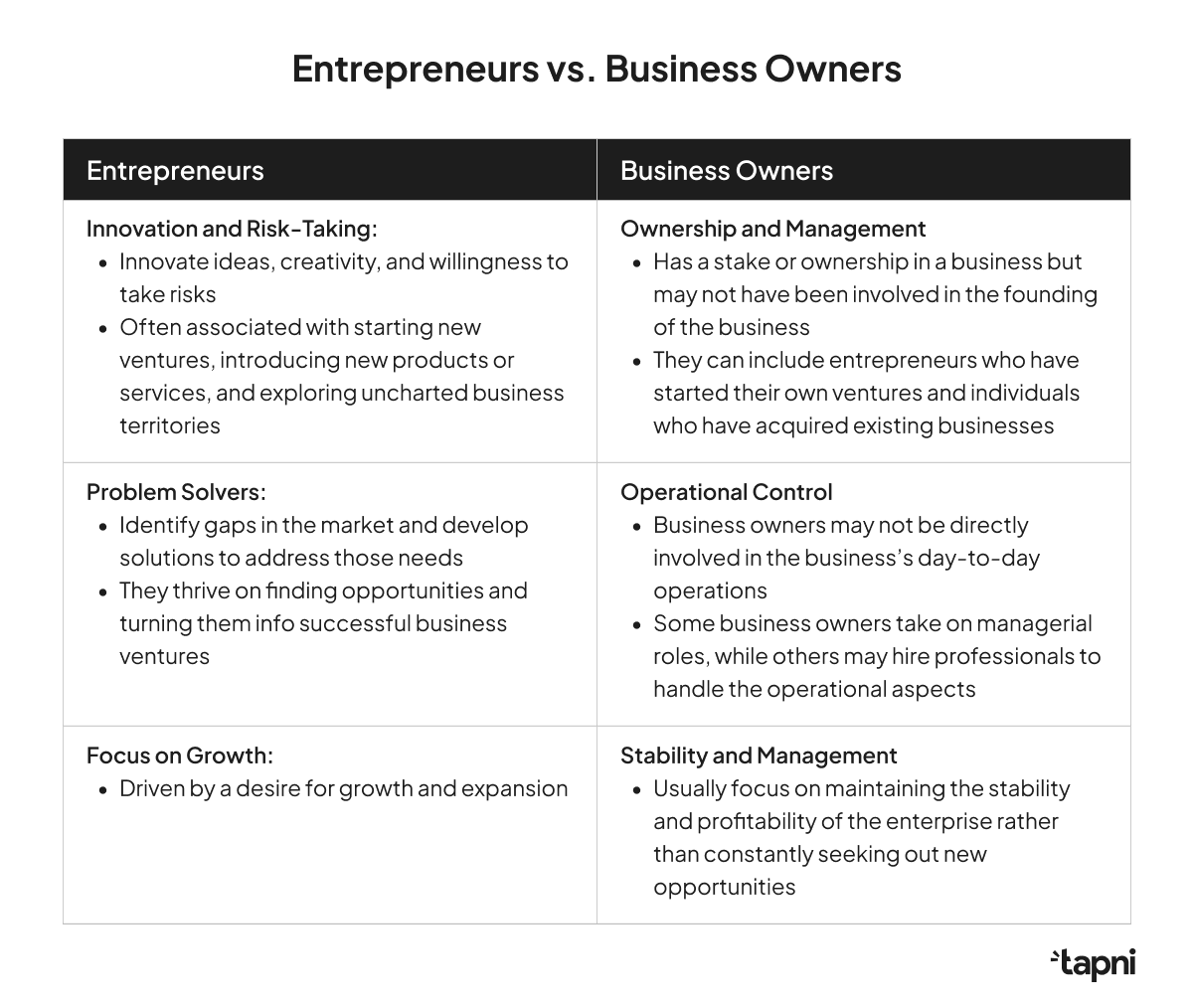Browse our comprehensive product guides and documentation

![11 Business Card Titles for Business Owners [+Examples]](/_next/image?url=https%3A%2F%2Fcdn.tapni.co%2Fcompany-media%2Fe411a6e5-e8c1-40b3-aa4c-1214cfb43e8a%2Fgallery%2Fimage%2Fb8f1cd07a68e28bb80c67decf1b5fe7404080500559841d4e34713a1481def77.webp&w=3840&q=75)
In the business world, first impressions rely heavily on a simple yet powerful tool - a business card.
As a business owner, your card is more than just contact information - it represents your role, your responsibilities, and the essence of your professional identity.
However, choosing the right title goes beyond mere semantics, and the right choice can be tricky.
It is about crafting a succinct and impactful description that communicates your leadership, expertise, and the unique value you bring.
Thus, your business card title is a key element of your brand, so knowing how to choose one is paramount.
Read on to find out which business card titles for business owners will fit your role best.
Let’s dive in!
A business owner title is a label you use to describe your role and responsibilities within a business or company that you own.
Thus, you can often include this title on official documents, business cards, and in professional contexts to communicate your position and level of authority within the organization.
Including business card titles for business owners is essential to effective networking, branding, and communication. To further enhance your professional presentation, you can also showcase your materials in a digital, interactive format using Flipsnack flipbook maker.
Business cards serve as a professional introduction, and including a specific title adds credibility and establishes your role within the organization.
In addition to showcasing professionalism, a business card title clarifies your position in the company hierarchy, making it easier for others to understand your role and responsibilities.
A clear title facilitates effective networking by conveying your position and expertise.
In businesses with multiple owners or partners, individual titles help distinguish each person's specific roles, which can be crucial for internal and external communication.
Including a business card's title helps build and reinforce the recognition of the business and its key individuals within the industry.
Since clients often receive business cards during meetings or transactions, a clear title can help clients understand whom they are dealing with.
Clearly defined titles for business owners can also impact internal dynamics because they help employees understand the leadership structure.
Having a consistent and accurate title on business cards can be important for documentation purposes.
And now, let’s check the most popular business card titles for business owners.

Founders initiate and establish a business, organization, project, etc.
As such, they are often the visionaries who conceive the idea for the venture, develop its initial concept, and take the necessary steps to bring it into existence.
Founders are key figures in the early stages of a company, contributing to its formation and shaping its direction.

A co-founder is a person who, along with one or more others, collaboratively establishes a business, organization, or project.
Co-founders share the responsibility for the creation and development of the venture and bring complementary skills, expertise, or resources to the partnership.
Furthermore, they typically share in the ownership and decision-making of the newly formed entity.

The CEO, or Chief Executive Officer, is the highest-ranking executive in an organization and is responsible for:
The CEO typically reports to the board of directors and, in turn, oversees the other top executives within the company.
The President is a top executive within a company, holding a leadership position involving a range of operational management responsibilities and strategic decision-making.
Although the job responsibility is similar to that of the CEO, the role of the President is more common in larger and more structurally complex organizations.
Consequently, the role of Presidents has a much wider scope.

A Vice President (VP) is a senior executive within an organization who holds a leadership position typically reporting to the President, CEO, or another top executive.
They oversee the activities within their designated domain and ensure that the department aligns with the organization's goals.
Furthermore, they also participate in strategic planning and decision-making processes.

A Managing Director (MD) is a high-ranking executive overseeing a company's day-to-day operations and overall management of a specific business unit.
The role of a Managing Director is crucial in ensuring the efficient functioning of the organization and achieving its strategic objectives.
The title "Managing Director" is commonly used in various industries, and the specific responsibilities can vary depending on the organizational structure.
Furthermore, the role of MD is more suitable in small to midsize businesses.

A Managing Partner usually holds a leadership role in a partnership-based business, typically a law firm, accounting firm, consultancy, or another professional services organization.
They manage external relationships, represent the company in legal matters, do employee management, and oversee significant business transactions.
A Business Development Director is a senior executive responsible for leading and overseeing the business development activities of a company.
Therefore, their role focuses on:

A General Manager (GM) is a top-level executive responsible for the overall management and performance of a business unit, division, or the entire organization.
Their role is critical in shaping the success and direction of a business unit or company.
Thus, this role combines strategic thinking, leadership, financial acumen, and the ability to drive operational excellence.
Generally, the GM’s task is to oversee the day-to-day operations, drive organizational objectives, and ensure the efficient and effective functioning of the business.

The COO is a key member of the executive leadership team and is often second in command to the CEO.
Therefore, the COO is a high-ranking executive who ensures business processes run efficiently.
Some of their tasks include:

A proprietor is an individual who owns and operates a business as a sole owner or solopreneur.
This means that the proprietor has complete control over the business, makes all decisions, and assumes all the risks and rewards associated with the business.
Choosing the right business owner title is crucial for effectively communicating your organizational role and responsibilities.
Different industries may have specific conventions for business owner titles.
For example, "CEO" might be more common in corporate settings, while "Founder" could be prevalent in startup environments.
Understanding industry norms ensures your title aligns with expectations and is easily understood by others in your field.
Choose a title that accurately reflects your day-to-day responsibilities and leadership role within the company.
This ensures that the title provides a clear understanding of your contributions and expertise, both internally and externally.
While your title should be specific enough to convey your role, it should also be universally understood.

Therefore, avoid overly obscure titles that may confuse people outside your industry.
If there are multiple business owners or partners, collaborate on choosing titles that accurately represent each person's role.
Consistency in titles among co-owners helps avoid confusion and presents a unified front to external stakeholders.
Before finalizing your business owner title, seek feedback from trusted colleagues, mentors, or industry peers.
External perspectives can provide valuable insights and ensure your chosen title resonates well with others.
Be mindful of cultural nuances if your business operates in multiple countries or serves diverse markets.
Some titles may carry different meanings or connotations in various cultures, so choose a culturally sensitive and appropriate title.
Your chosen title should align with the overall brand identity of the business.
Therefore, it should contribute to the image you want to project and reinforce the values and goals of the company.
If you anticipate changes in your role or the company's structure, choose a title that allows for future growth and expansion, especially in areas like video content creation and strategy.
This way, you won’t have to update your title frequently, ensuring its relevance as the business evolves.
To avoid overly complex titles, keep it simple and direct. This way, you’ll also ensure that people can easily remember and understand your title.

Although people tend to use the terms "entrepreneur" and "business owner" interchangeably, they can have distinct meanings depending on the context, like "debit card" and "crypto card".

While an entrepreneur is often associated with innovation, risk-taking, and a focus on growth through new ventures, a business owner is a more general term.
Thus, entrepreneurs can be business owners, but not all business owners may fit the traditional entrepreneurial profile.
The choice of a business owner title is not only a matter of personal preference but also a strategic decision that can impact how others perceive you, both within and outside the organization.
Choosing the right title is just one piece of a networking and managerial puzzle, and our digital solution, Tapni, can help you fit the remaining pieces.
Tapni is an all-in-one digital solution holding diverse things under its umbrella, from creating fully customizable digital business cards and accessories to robust features for teams and businesses.
Regardless of which business owner category you fall into, Tapni does the heavy lifting for you by:
💣 Automating your lead generation through various CRM Integrations - When you store contact information within the Tapni Teams app, you and your team can easily sync the data with your CRM or product experience platform (see, e.g., Pendo alternatives) using Zapier integration.
💣 Centralizing and monitoring leads gathered by your team to stay informed about data on lead ownership, locations, and essential notes.
💣 Providing actionable analytics enabling you to reward top performers, measure ROI at events, and take action based on these insights.
💣 Easily sharing your contact info in multiple ways - by tapping, scanning, via email, URLs, text messages, as an email signature, etc.
On top of that, Tapni comes with powerful networking-boosting features that enable you to:
✨ Quickly capture new leads through lead capture forms and an AI business card scanner.
✨ Facilitate hosting an event, event registration, organization, and audience engagement thanks to QR codes and various link types Tapni provides.
✨ Automate follow-ups and schedule them as reminders on your phones.
✨ and so much more.
Ready to take Tapni for a spin?
Download the Tapni app today and make your business card a true reflection of your business identity.